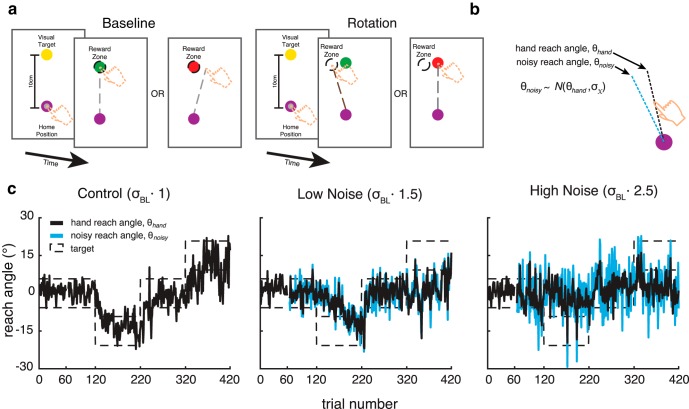Figure 1.
Task overview and single-subject example of noise conditions in experiment 1. a, Participants were required to make 10 cm reaching movements from a home position to move their finger, through a visual target. The entire arm was hidden from view during these reaching movements. At baseline, the reward zone was centered on the visual target. In the rotation phase, the reward zone was rotated relative to the displayed target. This required participants to learn to alter their reach angle relative to the target to counter the rotation so that the finger ended in the reward zone. Participants were given a binary feedback signal informing them of reach success or failure. Reach angles that successfully fell into the reward zone were reinforced with the visual target turning green. If a reach angle fell outside of the reward zone, the visual target turned red. The reward zone encompassed reach angles between the mean of the previous 10 trials and the rotated target position. b, Noise could be added to participants’ reach angles. The noise was proportional to each participant’s baseline variability, computed as the SD of the reach angles produced in the first baseline block on day 1 of the experiment, . On each trial, the θnoisy value was drawn randomly from a Gaussian distribution with a mean corresponding to the actual θhand and an SD such that the baseline variability would be increased by 50% (low noise) or 150% (high noise). Success or failure depended on whether the θnoisy value of the finger fell within the reward zone. c, Participants performed three sessions of the task on separate days, where each session corresponded to one task condition: control, low noise, or high noise. Each session began with a 60-trial baseline block with no rotation or added noise. This was followed by a second 60-trial baseline block with no rotation, but noise was added in the low-noise and high-noise conditions. Participants then performed 300 trials with closed-loop reinforcement feedback: 100 trials with the first 15º rotation; 100 trials to bring them back to zero rotation; and 100 trials with the second 15º rotation. Rotation directions and session order were counterbalanced across participants, but each participant performed the same order of rotation directions for the three experiment sessions.

